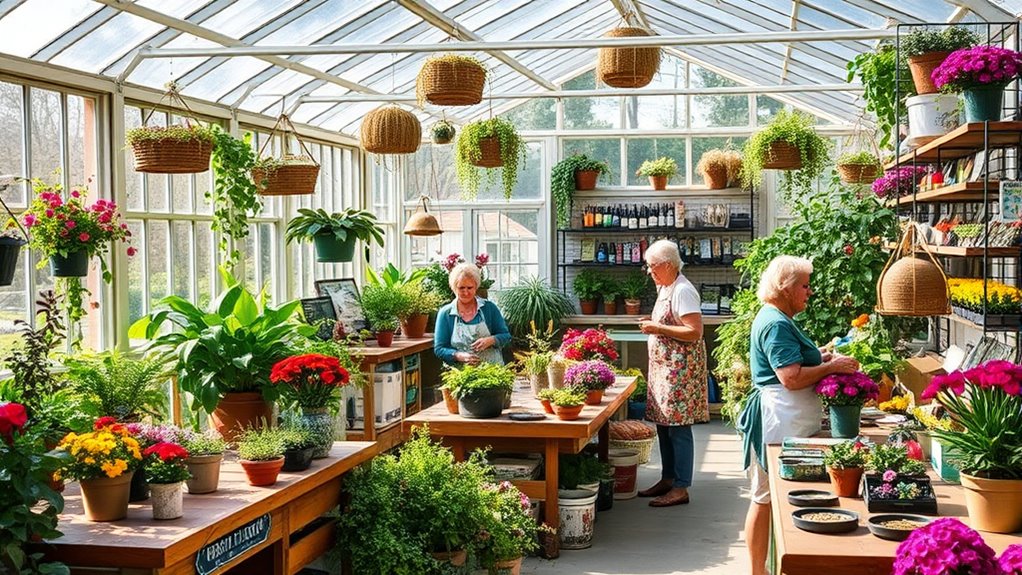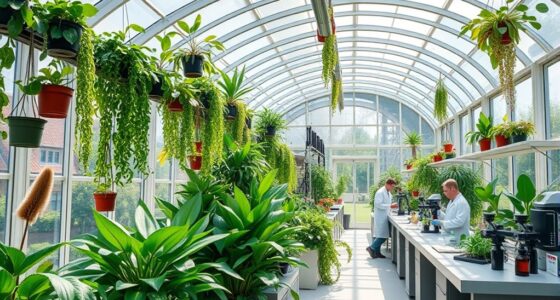To keep your greenhouse club active year-round, plan diverse activities that match each season, like indoor propagation projects in winter and outdoor planting in spring. Host workshops on sustainability, organic pest control, or native plants to engage members. Organize seed swaps, themed planting days, and social events to build community. By incorporating continuous projects and environmental education, you’ll foster enthusiasm and lasting involvement, ensuring your club stays vibrant and impactful throughout the year—more ideas await to inspire your planning.
Key Takeaways
- Organize seasonal workshops on indoor propagation techniques and sustainable gardening practices.
- Host ongoing seed exchanges, plant swaps, and themed planting days throughout the year.
- Develop community projects like composting systems and native plant initiatives to foster engagement.
- Maintain a club blog or journal documenting progress, successes, and challenges for continuous interest.
- Incorporate environmental education and sustainability demonstrations into regular activities to motivate members.

Greenhouse clubs thrive when they find ways to stay active and engaged throughout the entire year. One of the best methods is to organize seasonal activities that keep members involved, regardless of the weather outside. For example, during colder months, you can focus on indoor plant propagation projects. Propagating plants is a rewarding activity that not only teaches members about plant biology but also promotes sustainability. By practicing plant propagation, you give new life to cuttings, seeds, or divisions, helping the environment by reducing the need for new plants to be purchased. These activities also encourage members to experiment with different techniques, such as layering, grafting, or leaf cuttings, fostering a hands-on learning experience. As the seasons change, you can shift to outdoor projects like preparing the soil for spring planting or designing a composting system that emphasizes sustainable practices. Composting reduces waste and enriches your greenhouse soil naturally, making it a perfect activity to incorporate into your year-round programming. Incorporating sustainable practices into your activities not only benefits the environment but also educates members on conservation methods they can apply beyond the greenhouse.
To maintain engagement, consider hosting workshops or demonstrations that focus on sustainable gardening practices. These can include topics such as organic pest control, water conservation methods, or using native plants to support local ecosystems. When members see the environmental benefits of their efforts, they’re more likely to stay committed to the club’s mission. Additionally, creating a community-focused atmosphere encourages members to share their successes and challenges, which keeps the energy high and ideas flowing. You can also plan themed planting days, like a native plant day in spring or a drought-tolerant plant session in summer, to keep activities fresh and relevant to each season.
Another effective way to guarantee continuous involvement is to set up club-led initiatives that span the entire year. For instance, maintaining a plant journal or blog where members document their progress and experiments can foster ongoing interest. You could also organize seed exchanges or plant swaps, which are ideal for sharing sustainable practices and promoting biodiversity. These exchanges give everyone the chance to try new plants and techniques without additional costs, while also strengthening the sense of community. By integrating educational activities, practical projects, and social events throughout the year, you create a vibrant environment where members stay motivated and connected. Ultimately, staying active year-round requires planning, variety, and a focus on sustainability—ensuring that your greenhouse club remains lively and impactful no matter the season.
Frequently Asked Questions
How Can Greenhouse Clubs Attract New Members Year-Round?
You can attract new members year-round by hosting hands-on workshops on plant propagation and seed starting, appealing to beginners and experienced gardeners alike. Promote these events through social media and local community boards to reach a wider audience. Offer seasonal activities and themed planting days to keep members engaged and curious. Highlight success stories and showcase member projects to inspire others and foster a welcoming, vibrant greenhouse community.
What Are Cost-Effective Engagement Activities for All Seasons?
You can host cost-effective seasonal workshops to keep members engaged year-round. These workshops are inexpensive and foster learning and community spirit. Organize a plant exchange event to encourage collaboration and sharing among members, making it a fun way to stay connected during all seasons. Both activities require minimal investment but create lasting engagement, helping your greenhouse club thrive throughout the year.
How to Incorporate Technology Into Greenhouse Club Activities?
Imagine transforming your greenhouse club with cutting-edge tech that keeps members hooked year-round. You can incorporate smart gardening tools that monitor plant health and automate watering, making activities more interactive. Don’t forget virtual tours—these let members explore different greenhouses from anywhere, sparking curiosity and learning. By blending practical tech with immersive experiences, you create an engaging, innovative club atmosphere that keeps everyone invested, no matter the season.
What Safety Measures Should Be Prioritized During Year-Round Gardening?
You should prioritize safety by always wearing personal protective equipment like gloves, goggles, and aprons to prevent injuries. Guarantee emergency preparedness by keeping a first aid kit nearby and knowing emergency procedures for chemical spills or injuries. Regularly inspect tools and equipment for safety, and educate all members on safe handling practices. Staying vigilant and prepared helps minimize risks and keeps everyone safe during your year-round gardening activities.
How Can Clubs Partner With Local Communities or Schools?
You can partner with local communities or schools by organizing community gardening projects and environmental education programs. Invite schools to use your greenhouse for hands-on lessons, fostering student interest in sustainability. Collaborate with community groups to host workshops or gardening days, strengthening ties and encouraging shared stewardship. These partnerships promote environmental awareness and provide ongoing engagement, making your greenhouse a essential resource for learning and community building year-round.
Conclusion
By incorporating these year-round ideas, you’ll keep your greenhouse club thriving through every season. Staying engaged and creative guarantees your members stay connected and passionate about gardening. Remember, the key is to keep the momentum going—don’t let the grass grow under your feet. With a little planning and enthusiasm, your club will flourish all year long, proving that steady effort pays off. Keep planting seeds of inspiration, and watch your community grow!










